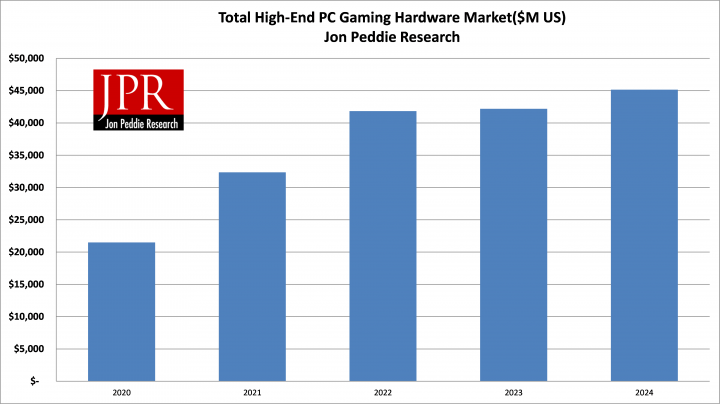PC Gaming Hardware Market Recovering, Supply Improving
General demand for gaming hardware and PC gaming hardware in particular has been high in the recent quarters as people spend more time at home during the pandemic. However, since hardware makers could not meet all demand for their products, a large portion of the consumer spending went to resellers, according to Jon Peddie Research. Having learnt from their missteps, hardware makers are adopting new business strategies to improve supply.
One of the reasons why manufacturers of PC hardware could not supply enough devices to meet demand was because their cautious approach to production capacities and inventories, operating in a Just-in-Time (JIT) capacity. Abnormally high prices of PC gaming hardware are not good for manufacturers at all as many consumers delay their purchases, others abandon the platform, and new entrants are sometimes put off.
To meet demand for their products and avoid steep increases of pricing, manufacturers are adopting new business strategies when it comes to production capacities and inventory levels, analysts from JPR say.
"PC Gaming Hardware companies are reviewing their Just-in-Time strategies and beginning to adopt Just-in-Case inventory level," said Ted Pollak, Senior Analyst Game Tech Industry at JPR. "As a result, we expect inventory and sales of High-End products to grow dramatically in the coming years. Additionally, Ultrawide and 4K+ displays are now available at big box stores and online for historically low prices. This helps drive CPU and GPU demand, full builds, and accessory sales to gamers."
While not all demand could be met, and is not going to be met for some time, sales of PC gaming hardware will increase from $21 billion ~ $22 billion in 2020 to $32 billion ~ $33 billion in 2021, Jon Peddie Research predicts. To a significant degree, this increase can be explained by a steep rise of graphics cards prices in the recent months.
Strong yet not anomalously high demand for high-end products may encourage manufacturers to "aggressively stock High-End inventory levels" to be able to meet demand and prevent prices from skyrocketing says Jon Peddie, the head of JPR. Since CPU and GPU developers no longer refresh their product lineups twice a year and often do not lower their MSRPs, the risks to component makers and resellers with expensive hardware seem to be manageable, so if they want to prevent situations like in the recent months, they may well be able to do it, analysts believe.
Get Tom's Hardware's best news and in-depth reviews, straight to your inbox.

Anton Shilov is a contributing writer at Tom’s Hardware. Over the past couple of decades, he has covered everything from CPUs and GPUs to supercomputers and from modern process technologies and latest fab tools to high-tech industry trends.
-
sepuko I don't care for improved supply as long as the prices are as high as that. At those prices that gaming hardware is as good as unavailable, who in their right mind would give $600 for low tier video card? Prices were supposed to drag down with the release of the latest AMD and Nvidia generations. Scalpers and miners turned that upside down. I hope karma is swift and merciless for those people.Reply
